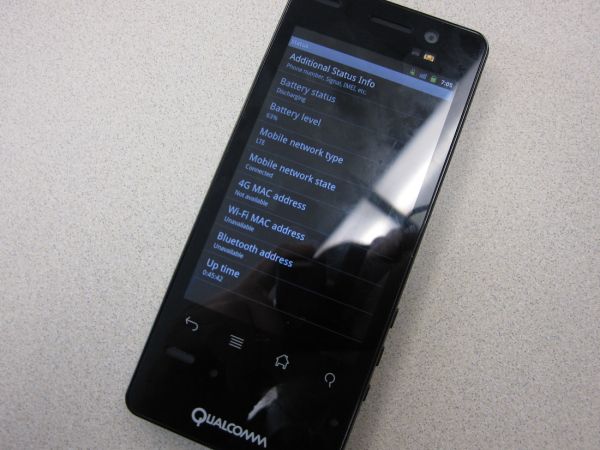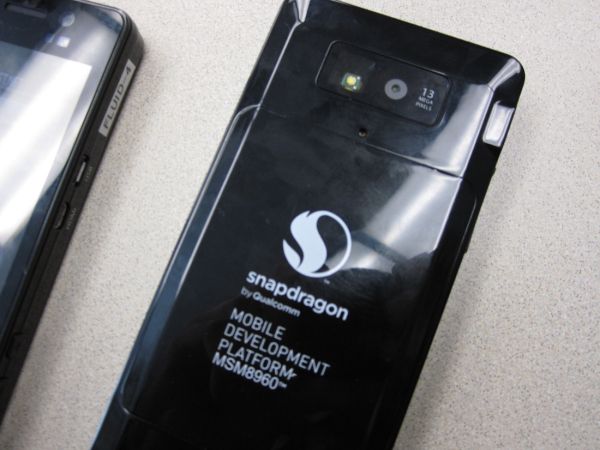Qualcomm's New Snapdragon S4: MSM8960 & Krait Architecture Explored
by Brian Klug & Anand Lal Shimpi on October 7, 2011 12:35 PM EST- Posted in
- Smartphones
- Snapdragon
- Arm
- Qualcomm
- Krait
- MDP
- Mobile
- SoCs
MSM8960 Cellular Connectivity
Until now, to get 4G LTE connectivity in a smartphone has required using two basebands - one for delivering 4G LTE connectivity, and a more traditional smartphone-geared baseband for voice on 2G and 3G data. Take Verizon’s 4G LTE smartphone lineup for example, where many devices combine MSM8655 for camping a 1x voice session alongside MDM9600 for EVDO and LTE, or some other similar combination. Further, all those LTE basebands are built on 45nm process and really geared towards data specific applications.
For a while now we’ve also been talking about 28nm LTE basebands, and specifically the multimode connectivity on MSM8960. This is the first of Qualcomm’s S4 SoCs, and includes 4G LTE connectivity alongside the usual assortment of WCDMA/GSM/CDMA2000 standards. MSM8960’s cellular baseband is based around Qualcomm’s second generation (3GPP Rel.9) LTE modem, which is exactly what’s inside MDM9x15 which we’ve talked about in the past.
The full laundry list of what air interfaces MDM8960 supports is impressive - LTE FDD/TDD, UMTS, CDMA, TD-SCDMA (for Chinese markets), and GERAN (GSM/EDGE). I’ve made a small table below which gives the full laundry list.
| Snapdragon S4 - MSM8960 Cellular Support | |
| LTE FDD | 100 Mbps DL / 50 Mbps UL (Cat. 3, 3GPP Rel.9) |
| LTE TDD | 68 Mbps DL / 17 Mbps UL (Cat. 3, 3GPP Rel.9) |
| UMTS | DC-HSPA+ 42 Mbps DL (Cat. 24) / 11 Mbps UL (Cat. 8) |
| CDMA2000 | 1xAdvanced, EVDO Rev.B (14.7 Mbps DL / 5.4 Mbps UL) |
| GSM | GSM/GPRS/EDGE |
| TD-SCDMA | TD-SCDMA 4.2 Mbps DL / 2.2 Mbps UL |
What’s new again is inclusion of a category 3, 4G LTE baseband into the SoC alongside DC-HSPA+ and TD-SCDMA for the Chinese market. This is a substantial increase in the number of air interfaces supported onboard the SoC which will enable tighter integration and lower power from the baseband being manufactured on that same 28nm process. There’s still the requirement for external RF and transceiver (using RTR8600 or something similar) which houses all the analog, but that’s the same everywhere else.
Since the baseband in MSM8960 is shared with MDM9x15, the two are both 3GPP Release 9 devices, whereas presently MDM9600 and other launch LTE devices are 3GPP Release 8, which was the launch standard. This newer 3GPP release brings a number of improvements, and closer to transitioning to Voice over LTE (VoLTE) and SRVCC (single radio voice call continuity) for fallback to GSM/UMTS or 1x voice in the circumstance that 4G LTE coverage fades. The present combination of a camped 1x voice session alongside 4G LTE for data is also possible in MDM8960, which is exactly what’s done in the case of the HTC Thunderbolt.
In time, carriers will transition to using VoLTE and enrich the voice experience by offering services that work across the data session, alongside some circuit switched (CS) traditional 2G/3G voice to fall back to. For CDMA networks that’ll continue being the dual RF scenario which uses 1x for voice, and for UMTS networks that’ll be a SRVCC augmented fast handover to 3G for voice calls. This handover and call setup is targeted to take place in under one second.
There’s more to the connectivity situation as well, as MSM8960 includes built in WLAN 802.11b/g/n (single spatial stream), Bluetooth, and GPS. These are integrated directly into the MSM8960 the same way the cellular modem is and only require some external RF to use.
Of course, it’s one thing to talk about all this connectivity on MSM8960 and something else entirely to see it. With MSM8660, Qualcomm gave us one of their Mobile Development Platforms (MDPs) which is something of a reference design and development board for each SoC generation.
This time was no exception, and they showed off their new MSM8960 MDP connected to Verizon’s 4G LTE network streaming 1080p YouTube video, loading pages, and finally running a few speedtests using the Speedtest.net application.
This was all over Verizon’s 4G LTE network at Qualcomm HQ in San Diego and worked impressively well for hardware and software that still isn’t production level. In spite of marginal signal in the room we performed testing in, the MDP finished tests with pretty decent results. I ran some more tests on a Droid Bionic in the same room and saw similar results.
Final Words
Qualcomm has had MSM8960 silicon back in house for the past 3 months and is on-track for a release sometime in the first half of next year. Assuming Qualcomm can deliver on its claims, performance alone would be enough to sell this chip. Improved power characteristics and integrated LTE baseband really complete the package though.
The implications for a 1H 2012 MSM8960 release are tremendous. Android users will have to choose between a newer software platform (OMAP 4 running Ice Cream Sandwich) or much faster hardware (MSM8960). Windows Phone users may finally get a much needed performance boost if Microsoft chooses to standardize on Krait for its Windows Phone hardware refresh next year. End users will benefit as next year's smartphones and tablets will see, once again, a generational performance improvement over what's shipping today. LTE should also start to see much more widespread adoption (at the high end) as a result of Qualcomm's integrated LTE baseband.












108 Comments
View All Comments
Zingam - Saturday, October 8, 2011 - link
And in that case you don't really need a tablet. Tablets would be very useful if they could deliver some kind of alternative user input and display. For instance: holographic displays (like in sci-fi movies) and voice control and input. That would actually make these mobile devices truly useful. The current generation and the coming generations would be nothing more than mobile browser and mp3/mp4 player.FunBunny2 - Saturday, October 8, 2011 - link
And, if it could work at all, how well would voice control work outside of an anechoic chamber (with a lone user talking to it)? But, I agree, tablets (used for decades in warehouses, by the way) will soft keyboards and the like are just a cheap and dirty way around the I/O issue.bjacobson - Saturday, October 8, 2011 - link
wow not sure what happened there.What I mean is we'll get a quad core phone with 4GB of RAM and all we'll need is a tablet to dock it to. The tablet will have the other connectivity options-- HDMI, USB, etc which will let the non-gamers replace their desktops and the people not needing Windows for business, replace their laptops.
dagamer34 - Saturday, October 8, 2011 - link
The dedicated gaming desktop will largely be obsolete in a few years. Games are much more GPU dependent than CPU dependent. What we will see is the era of external graphics cards which you can hook up to your laptop to play on your monitor @ 1080p with all the special effects turned up. Then you "undock" and rely on the integrated GPU to get longer battery life.Best of both worlds!
Death666Angel - Friday, October 7, 2011 - link
Thanks for the write up, pretty interesting stuff to come next year. Hopefully developers will embrace the new power, so that I can make fuller use of my Galaxy S2. I don't think I'll upgrade that soon though, pretty content with Galaxy S2 and it was expensive enough for now. I'll see what Christmas 2012 brings. :Dcnxsoft - Friday, October 7, 2011 - link
Back in February, Qualcomm also announced the quad-core Snapdragon APQ8064 would be ready in 2012. Any news on that ?HighTech4US - Friday, October 7, 2011 - link
Nvidia's roadmap clearly shows Kal-El+ as mid 2012 and 28nm Wayne at the end of 2012http://www.androidcentral.com/nvidias-tegra-roadma...
BoyBawang - Saturday, October 8, 2011 - link
Does it mean all Krait cores will be manufactured in LP like the Companion CPU of Kal-EL for energy efficiency that's why it won't go beyond 2ghz even at 28mm?skydrome1 - Saturday, October 8, 2011 - link
I know this article's on the Krait architecture, but in your comparison of the 2011/2012 SoC roadmap, I think you left out one very promising competitor: the ST Ericsson Nova A9600.Could this be included? And will there be any updates on this upcoming SoC?
On the whole, the 2012 roadmap looks really good. But I personally am looking forward to PowerVR's Series 6, the Cortex A15 MP and NVIDIA's Wayne the most.
Zingam - Saturday, October 8, 2011 - link
Hollyday season 2013